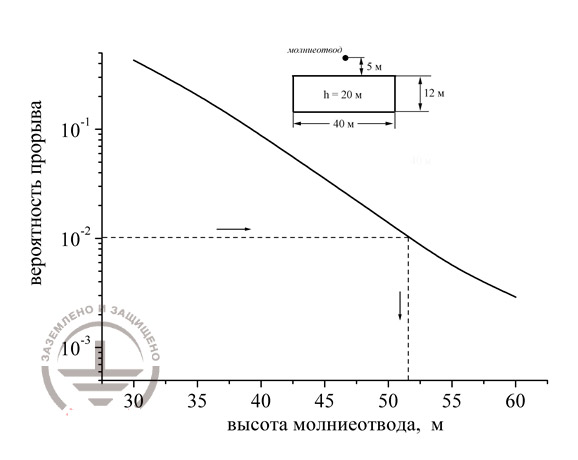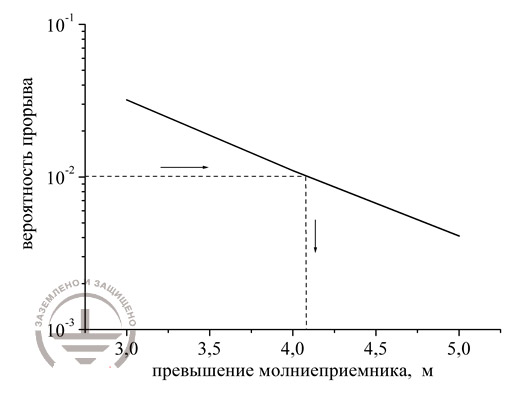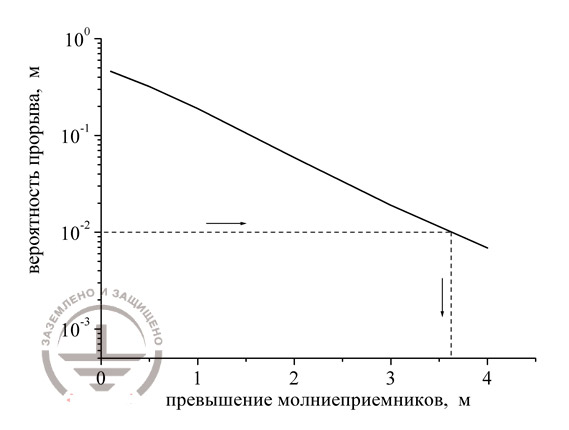As mentioned earlier, the statistical method does not foresee introduction of any restrictions on the number of buildings to be protected, as well as the number and configuration of the lightning rods being installed. By means of a statistical technique, it is possible to detect the probability of a lightning breakthrough absolutely anywhere. It can be a complex of buildings or some separate site. For these purposes only the selected area is considered as the object of protection. As for the rest structures, they are formally set equal to lightning rods. At the same time, there are no restrictions either on the number of lightning rods or on their height. It should be taken into account that this technique is able to demonstrate the development of orientation of the downward lightning. In order to make this process more visible in the lightning protection calculation formulas according to the statistical method, the parameter nM was introduced, which means the density of lightning discharges on the ground surface where electromagnetic disturbances caused by lightning discharges were not present before.
Experimentally, it was revealed that, starting at the height of 200 m, the parameter nM practically does not affect the number of downward lightning. In this case, the total number of thunderstorms increases mainly due to the upward discharges, which rise from the top of the building. This refers to high-rise buildings built on a flat terrain.
Based on the foregoing method, lightning protection calculation technique can be used for buildings up to 200 m high. At the same time, there are restrictions of height up to 150 meters in the "Instruction IS-153-34.21.122-2003".
In the statistical methodology, it is recommended to use protection zones exclusively for preliminary estimation of lightning rod heights. This is due to the fact that in most situations the results obtained are significantly overestimated even in case of a single rod lightning rod. For example, to protect the structure with a reliability of 0.99 at its height of 20 m and dimensions of 40x12 m, an air-terminal mast 62 m high is needed. Having carried out the calculation according to the formulas proposed in the statistical method, we obtain the height of a lightning rod equal to 52 m. Thus, without reducing the reliability of protection from lightning, we could achieve significant savings when installing rod lightning rods. This is shown in Figure 1.

Figure 1. Without sacrificing the reliability of lightning protection, considerable savings can be achieved when installing rod lightning rod
The advantages of the statistical methodology become more visible in those cases where it is necessary to reduce the height of lightning rods by increasing their number. In solving such problems, there may be a need in cases when not lightning discharges are more dangerous for an object or equipment located on it, but the effect of high-power electromagnetic fields.
The use of high-rise lightning rods to protect against lightning causes a significant increase in close lightning discharges. In this case, the magnetic field of the current that flows through the lightning rod will be almost the same as when the lightning strikes the object itself. The methods of the statistical technique can be easily applied when it is necessary to perform a lightning protection calculation for a group consisting of several rod lightning rods.
If we take the data from the previous example, now with the use of statistical methods it is possible to provide protection of the building with the same reliability of 0.99 by installing only 4 lightning receivers at each corner of its roof. In this case, the required excess is equal to 4 meters. This is demonstrated in Figure 2.

Figure 2. With the use of statistical techniques, it is possible to provide protection of the building with the same reliability of 0.99 by installing only 4 lightning rods on each corner of its roof
It is established that such a lightning protection system will take lightning strikes about 6 times less often than a rod lightning rod 60 meters high. The statements about the high effectiveness of lightning protection meshes can also be easily refuted by using the calculations adopted in statistical techniques. This is illustrated in Figure 3. In this case, it is assumed that the protective mesh is placed on the roof of the building that has already been considered. When exceeding in 3.6 m the probability of a breakthrough will be at the level of 0.01. This is almost the same as the examples given earlier. If to raised the mesh to the distance indicated in the IS-153-34.21.122-2003, which is approximately equal to 0.1m, the probability of a lightning breakthrough in this case will approach 0.5. Thus the protective effect of using the mesh will be almost completely leveled.

Figure 3. Denial of the high efficiency of lightning protection meshes
The statistical technique is based on an analysis of the scatter of breakthrough stresses of large areas. However, its methods are also effective in situations where the dielectric strength of the electrode system changes under the influence of external influences.
The material was created on the basis of an article by Professor Eduard Meerovich Bazelyan "Possibilities of statistical methodology"
See also:
- Useful materials for grounding and lightning protection designers (articles, manuals, guidelines)
- Design of grounding and lightning protection (projects in DWG and PDF formats)
- Webinars for designers and electricians with the leading experts
- Become a partner and join the ZaNDZ.com Club of Experts
- Equipment for grounding and lightning protection
Related Articles:
 6. How to do that?
6. How to do that?

